Studio Visit
Musically Gifted Artist Oliver Beer on Painting With Sound and Making a Spine-Tingling Opera in Paleolithic Caves
We caught up with the multidisciplinary artist for a studio visit at his workshop in London.
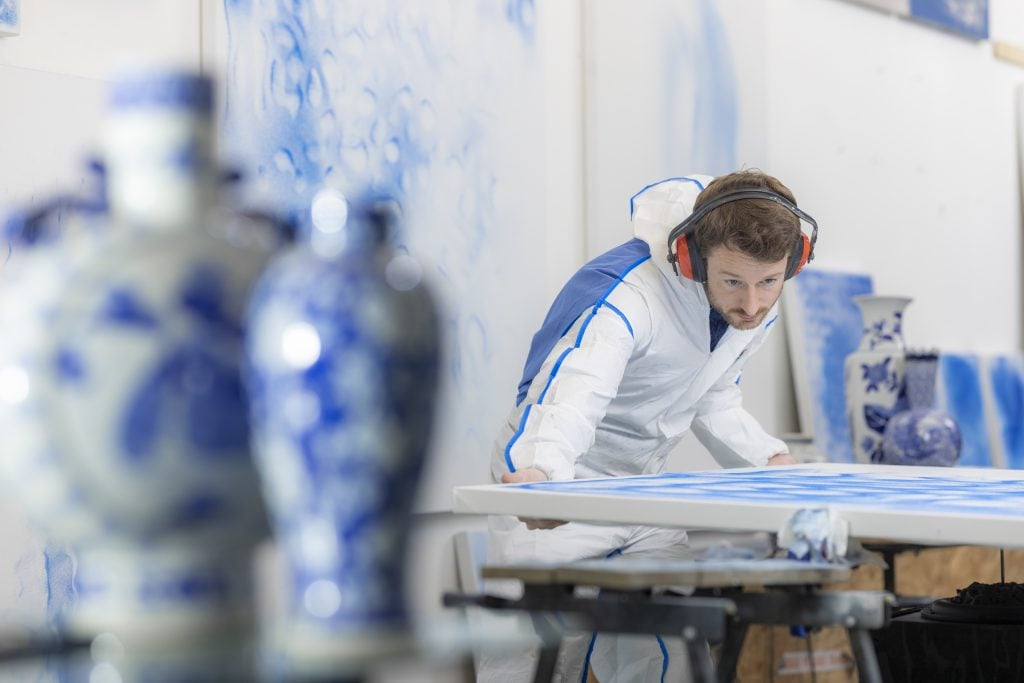
We caught up with the multidisciplinary artist for a studio visit at his workshop in London.

Naomi Rea

The setting for Oliver Beer’s studio, nestled beneath a set of noisy railway arches in South East London, didn’t feel like a natural fit for an artist whose work deals with the music and barely perceptible sounds.
Then again, as he greeted me wearing a boiler suit with a pair of ear defenders around his neck, the location means he’s likely to never to get a noise complaint from the neighbors.
Although the workshop part of Beer’s studio was cluttered with broken instruments and differently shaped objects, the rows of clear plastic boxes, meticulously labeled, felt more in line with the personality of the artist, who seems carefully articulate and attentive.
Beer has a gift for being able to hear the natural resonance of any room or hollow object. He can also tell you, just by listening, what key a sound is in. He channelled this talent into studying composition at university, and had a stint as a member of an indie rock band before making his name as an artist.
As he toured me around the workshop, he introduced some of the objects in the room, picking up an elephant shaped vessel, singing its note into it, and causing it to hum right back at him in harmony.
His eclectic collection of vessels is dear to him, and has formed the basis of many bodies of work; perhaps best known is a project created using 32 objects from the Met’s collection. Beer built a playable orchestra out of the natural resonance of the artifacts. A kaleidoscopic collection of cats in another part of the studio gave away that he is now working on a cousin of the Met project, a “cat orchestra” inspired by a 17th-century da Vinci-style polymath’s unhinged designs for a cat organ.
Another work, currently on view at the London Mithraeum, allows visitors to amplify the acoustic resonance of vessels found on the former site of the historic Roman temple. Also on view in that exhibition are a series of new paintings he has dubbed “resonance paintings,” which are created without ever touching the canvas. By blasting sound beneath a canvas covered with pigment, the particles of color come alive like tiny little ravers, dancing across the canvas to create remarkable abstract paintings.
He expands more on this process in the conversation below.
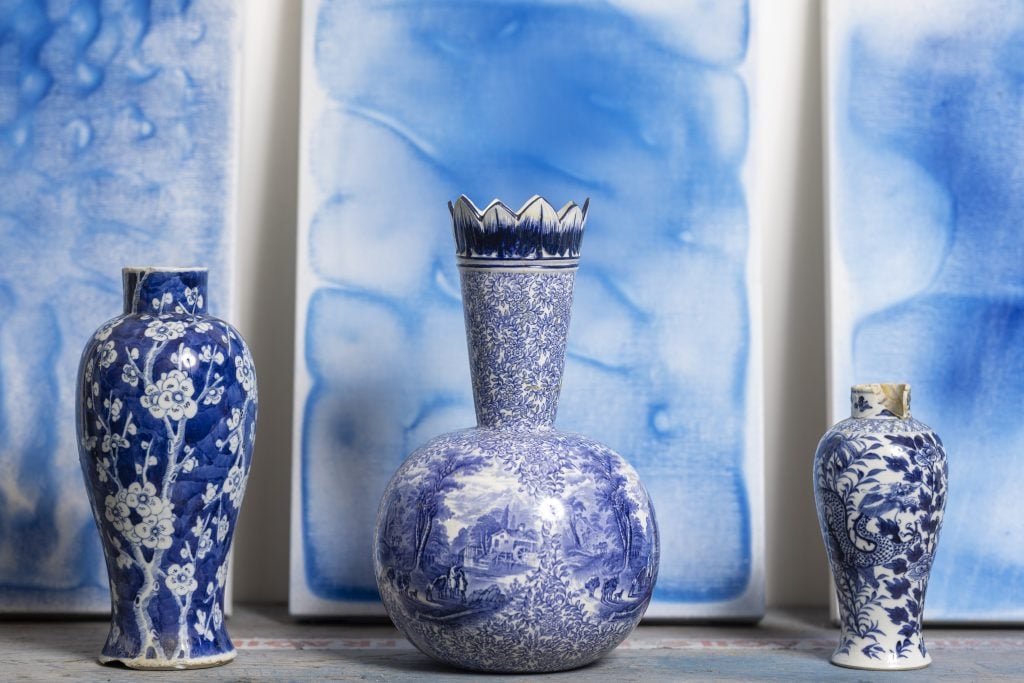
Oliver Beer’s studio. Photo by ©Jason Alden.
Music is obviously a big part of your life. What’s on your playlist at the moment?
I’ve been listening to very diverse things. Everything from pretty hard electronic slash ambient slash classical [sic]. I think because I studied music, and because I’ve worked with so many musicians of different genres, I have a very eclectic taste.
Last night I was listening to an incredible Shostakovich prelude, a song by this group called Low, which is super intense electronic—their song Quorum. Also a Haitian singer called Melissa Laveaux, who I’m working with at the moment. She’s incredible and sings her own contemporary interpretation of Haitian music.
Tell me about the “resonance” paintings—is this a new body of work?
This is a body of work that started during the lockdown, though it originated in a piece that I made in around 2008 or 2009 when I was still at Ruskin [College], in my second year. I put a handful of flour on an Irish drum and I put a speaker underneath it, and because I studied music and music is a big part of the way I experience the world, I was able to essentially tune the music to the drum and make that flour go into the most beautiful cosmic patterns through the vibrations.
For these new works, I have taken a horizontal blank canvas rather than a drum, and placed the finest possible pigment on the surface so the sound moves the pigment into that same geometric shape. I’m able to paint very deliberately and carefully on the canvas without ever touching it, by using sound as my paintbrush.
What I’ve been working on for a long time is the form of music—the fact that music really has a shape, literal geometric shape, which people don’t really understand or appreciate. Usually when you go to a concert, you think you’re only listening to vibrations, but if you could see the vibrations like on the surface of water, you would be able to see that the music is coming at you, filling the room with the most beautiful geometric, three dimensional patterns.
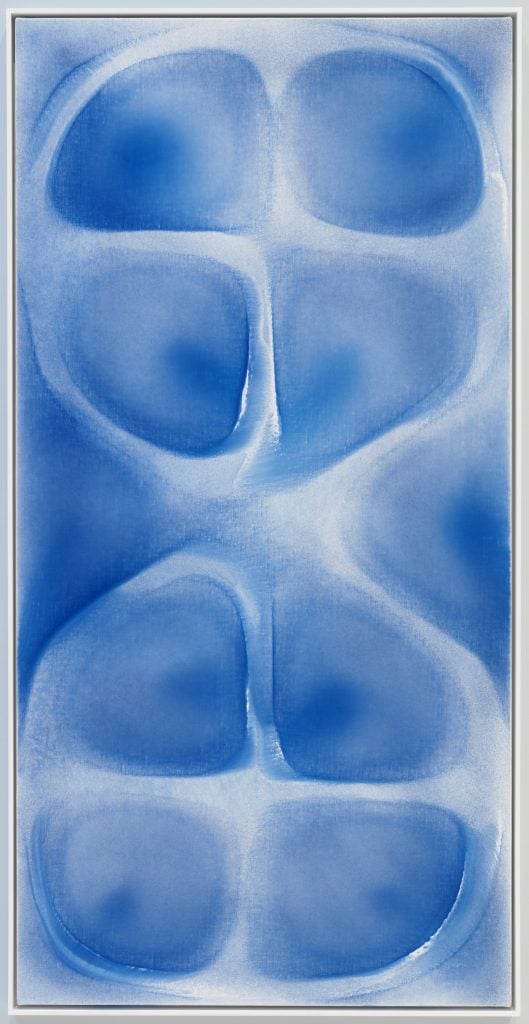
Oliver Beer. Installation images from “Albion Waves”. ©Marcus Leith.
What would you say is the most indispensable item in your studio?
A lot of the work I’ve done is to do with the voice. Human voice is the most deeply charged, instrumental area. It’s both a musical instrument, but it’s also your most fundamental means of communication. And what gets me about the voice when we talk to each other is that like all those vibrations in the “resonance paintings,” our voices are doing the same thing in the air between us. So we’re actually constantly sending geometry and form at each other, and our brain interprets that geometry as intelligible sound.
Our voices are also making every single atom vibrate in synchrony. So when I speak, every single atom in your body is moving in synchrony with that vibration. That’s an incredible way of being in touch with each other, like literally touching each other with our voices. I think when you have a singer, for example, it becomes all that much more compelling because you go to a concert and everyone in the room is literally being moved by that same sound, which is just the vibration of the vocal cords, it’s so simple.
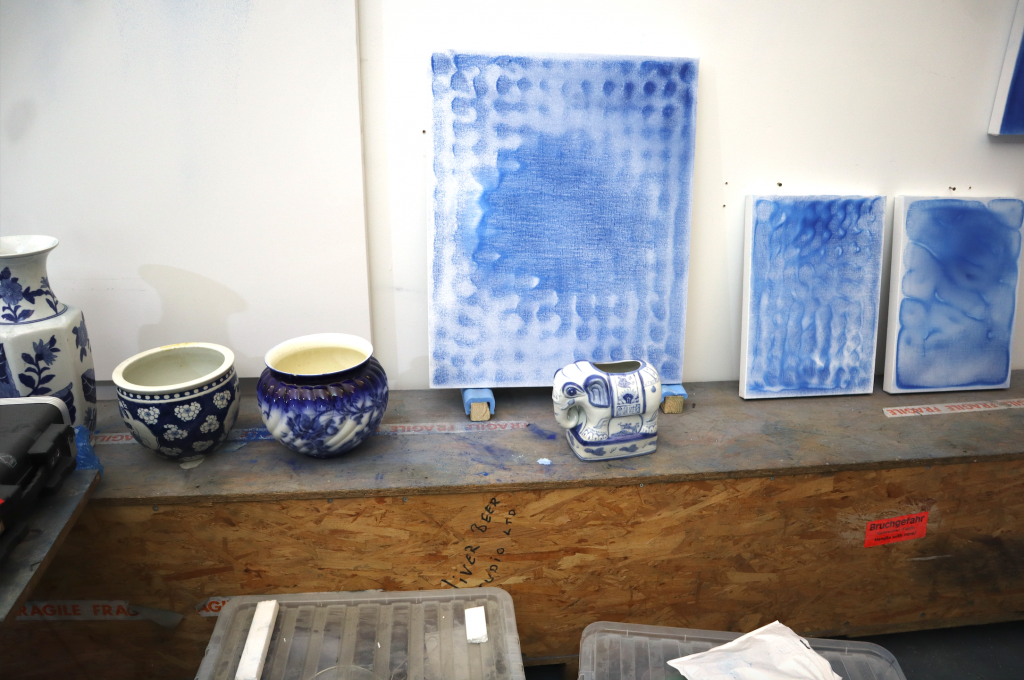
Oliver Beer studio. Photo by Naomi Rea.
You’re working on a pretty special project at the moment, for the paleolithic caves in the south of France. Can you tell me more about that?
I’m shooting a video opera in the famous painted caves, home to the oldest art in the world. I managed to get the keys from the French government. I was just rehearsing with Rufus Wainwright last weekend here; he’ll be in it.
The caves are closed to the public now, because they are so fragile, aren’t they?
Lascaux is closed. The part that I have access to is very limitedly accessible. They have a very strict amount of time that you can spend in there, calculated in hours of breath. So it’s particularly exceptional that they’ve let me in with singers.
Caves are just like giant vessels. And I found a way of making the caves sing, just by whispering to the walls. And when you do that, they sing back so loudly that you cannot even hear your own voice anymore, you just hear this incredible sound coming from the caves. I’ll go down seven times with seven different singers and they’ll all sing a duet with the cave. And when I cut it together, they’ll all be perfectly in tune with each other. Because the cave has never changed its note, it becomes like a tuning fork, keeping everyone in tune.
What will they be singing?
The principle behind the caves opera is that every singer who I’m working with will giving me the earliest musical memory that they have in their entire lives, which will almost always come from a parent or grandparent, and I’m weaving those seven melodies into seven part polyphony, which the cave will force into harmony with each other. So even though they’re from the most diverse possible backgrounds—from Haiti to North America to France to Lebanon—they will be singing their inherited music in perfect harmony thanks to this space. The space becomes this cultural unifier in some way.
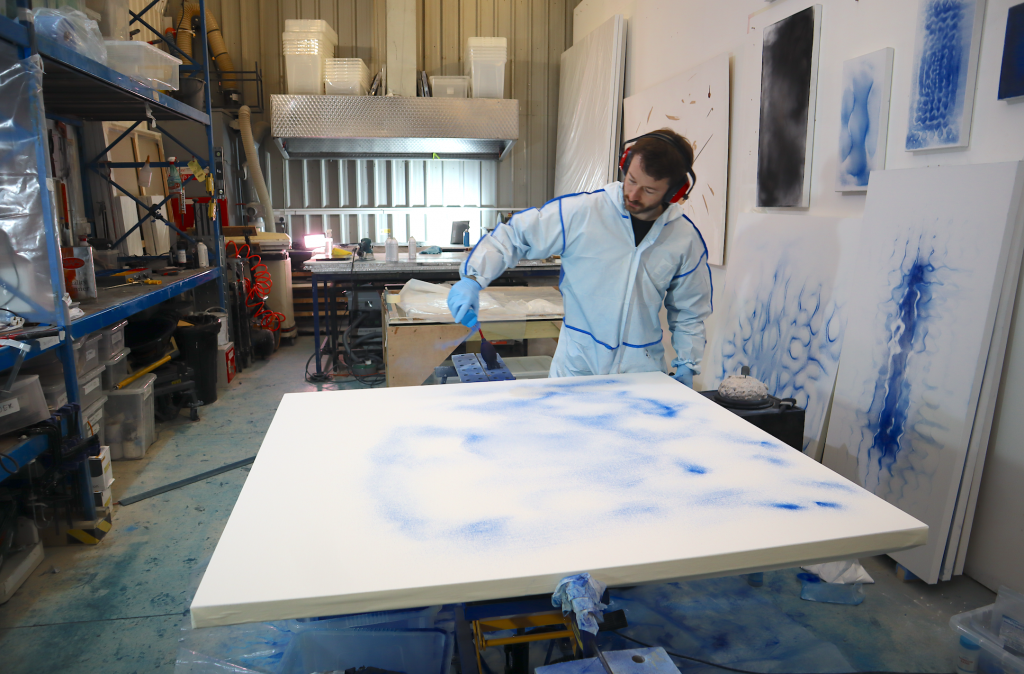
Oliver Beer in the studio. Photo by Naomi Rea.
How many studio assistants do you work with to pull off projects like this?
We have so many different projects so that number grows and shrinks according to what we’ve got going on. The video opera obviously is a major project—it’s actually a prize from the French government. Macron put €30 million behind post-pandemic projects and part of that has funded this very ambitious film work. I’ll work with a production company on that.
I’ve got a show with the Museum of Modern Art in Paris next year, “Reanimation Paintings,” and it’s going to take a lot of organization as well. It will be inspired by seven paintings in the collection—ten thousand different children will each redraw one of the seven paintings, and those thousands of drawings will be scanned and printed onto celluloid film and projected to become like living canvases of each original painting seen through the psychedelic originality of the children’s vision. At the same time, I’ll record thousands of their voices in a recording studio that I’ll build in the gallery. And I’ll work all these sounds into a very intense musical soundtrack for the final seven screen immersive installation which will represented in 2024.
So the studio has to be very nimble.
Is there a typical day in the studio for you?
I have so many things that I want to make so I have to try to carve out time to do them whenever I can. The process for the “resonance paintings,” is very musical. It’s quite emotional, and it’s actually quite exhausting because I need to be very alert. It’s a bit like jazz improvisation, with a clear structure and lexicon though new possibilities can arise in the moment. So I’ll try and find a few times in the week where I can really quietly do that for several hours. Actually it’s not quiet, I’ll be making loads of noise.
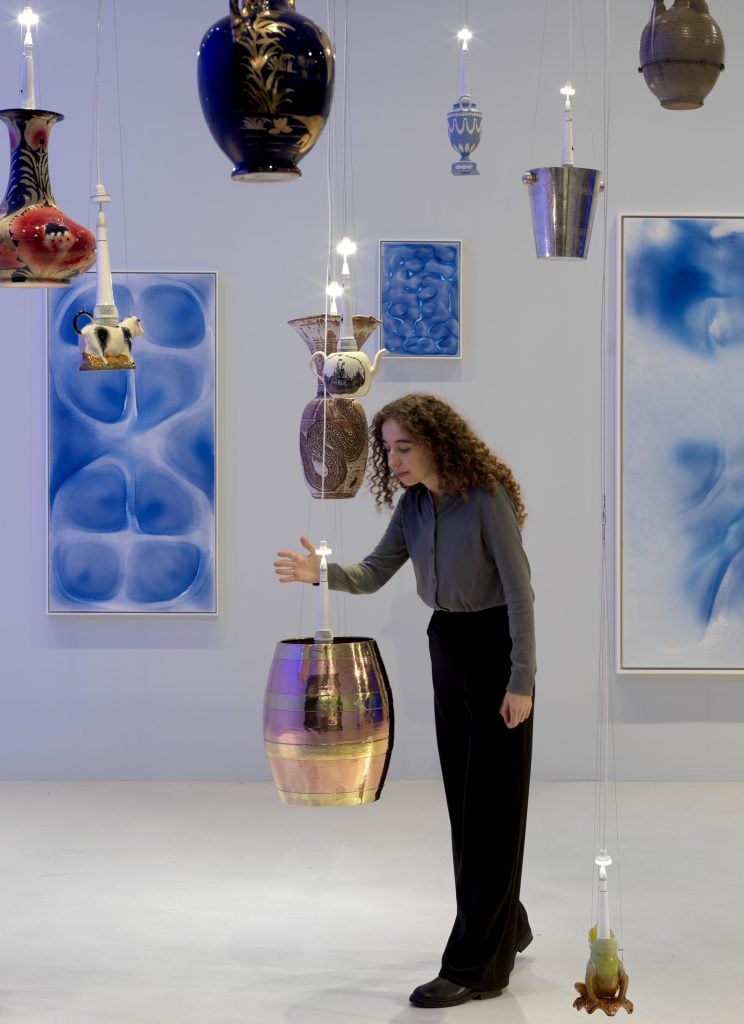
Oliver Beer. Installation images from “Albion Waves”. ©Marcus Leith.
Vessels are a big part of your practice and you’ve involved different kinds in different ways—how do you go about sourcing them?
Originally I used objects from my own family, [like those] in the British Art Show [which closed in December] in Plymouth. That’s nice because it’s like a portrait of my family, but obviously you only have so many vessels in your life. That’s why the show at the Bloomberg Space [at the London Mithraeum] has become a portrait of British vessel-making going back 2,000 years.
The [institution] has these incredible objects from different periods of history that they found on the site of the Roman temple. It has been really fun to delve into the nature of British taste and object-making. I’ve collected a pretty democratic cross section of objects going back 2,000 years. They are suspended from the ceiling, and activated by movement sensors that detect the body’s presence: people will stand under them and the vessels will sing their notes.
It’s a really nice opportunity to do what I did at the Met, which is to take this acoustic principle and apply it to a collection of objects. At the Met, 21st-century objects were alongside sixth millennium BC objects, and they were perfectly coherent together, which was very museologically challenging for the museum. They have a hierarchy and protocol as to how objects are presented and why, and it took a lot of conceptual convincing for them to recognize that this way of understanding the objects was really valuable. I had to individually coax each of the conservators and curators from each department to collaborate on the project. Once we had achieved it, it became a playable instrument that harmonized objects from diverse cultures and civilizations.
What do you do whenever you are feeling stuck or in a rut?
I haven’t really had time to feel stuck or in a rut for forever. I think if anything it’s the other way around. There’s so much that I want to build. During the lockdown I designed 12 acoustic pavilions, where the form of the architecture will create the most incredible natural sounds—now I’m working on finding places to build them.
The lockdown was amazing for me. I was very fortunate that it was a very productive time because I wasn’t able to go out, so I was able to compile all my drawings. Now, really, I’m burning to make everything, I just need the time and the resources to do it.
“Oliver Beer: Albion Waves” is on view through July 15 at London Mithraeum Bloomberg SPACE.
More Trending Stories:
Superstar Painter Peter Doig Has Parted Ways With His Longtime Gallery Michael Werner After 23 Years
Here’s Your Go-To Guide to All the Fairs Taking Place Over Frieze Week in Los Angeles